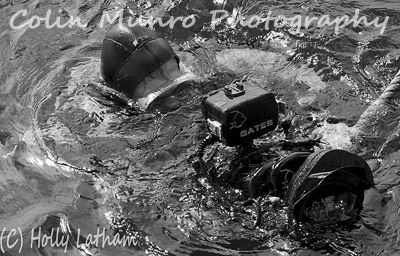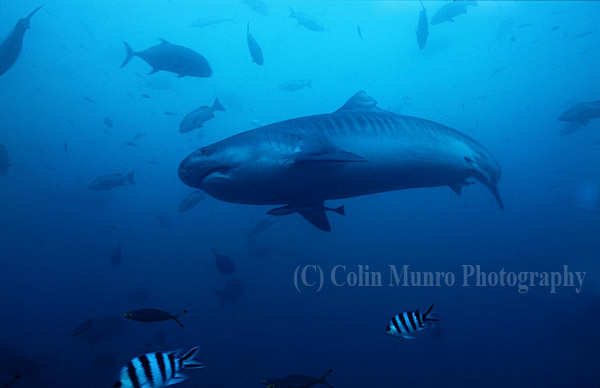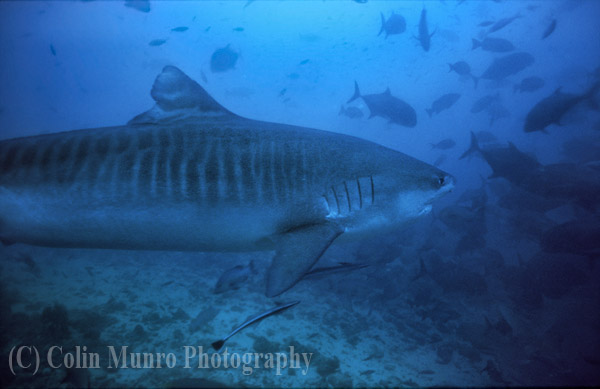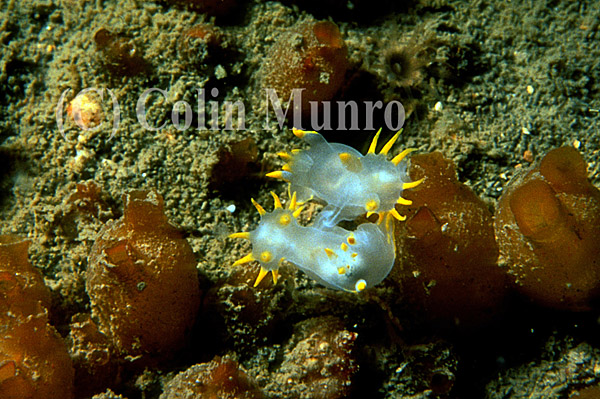I often see needlefish when snorkelling around the Andaman Sea shores of Western Phuket and Peninsular Thailand. Needlefish, or long toms as they are commonly known in Australia, are predators of (mostly) small fish; They inhabit surface waters where their long, slender form and silvery scales render them almost invisible until quite close. I generally encounter them hanging around the periphery of reefs, or cruising around piers, just beneath the surface, and sometimes in very shallow water, surfing in on small waves to where the water is only a few inches deep. They patrol these areas in small groups of up to a dozen or so, moving like hunting dogs, looking to sneak close enough to an unwary sardine or silverside to pounce. Usually they will suddenly launch themselves forward at speed into the school of small fish, hoping to grab one as they scatter. Off heron Island, on Australia’s Great Barrier Reef, they have been observed to launch aerial attacks; leaping clear of the water, to land amongst the unsuspecting school of bait fish. I’ve never personally observed this and as far as I know it’s never been recorded around Thailand.

Needlefish have a reputation for being dangerous to swimmers and fishermen. While far from aggressive (they’re actually quite timid and tricky to approach close) there have been a number of injuries and indeed some fatalities caused by needlefish. The problem is that when needlefish feel threatened, they will often leap out of the water; long, low leaps, travelling at speed and covering some distance. I’ve seen speeds of 40 mph through the air mentioned, though I suspect this is little more than a guesstimate. With their long, thin needle-like jaws it’s easy to see how being unlucky enough to be stuck by one could cause serious injury. In November 2020, a Hawaiian man out sea canoeing found himself in the middle of 30-40 needlefish leaping out of the ocean. Several stuck his canoe, one puncturing straight through the fibreglass canoe hull. In Nha Trang, Vietnam, in 2014, a Russian tourist was swimming when she felt a sharp pain in her neck. She was rushed to hospital suffering partial paralysis. Emergency surgery removed fragments of needlefish jaw, and teeth, from around her spinal cord. Fortunately she made a full recovery. Though incidents can be very nasty they are also, thankfully, very rare. Fatalities are extremely rare, but do happen. In 2018 a young Thai cadet training with Thai navy special forces died after hit him in the neck during a military training exercise.
There are probably more incidents that go unrecorded; local artisanal fishermen are generally at much greater risk due to the amount of time they spend in the water or in small boats, especially at night. Lights, often used to attract fish, are known to attract or create panic in needlefish, causing them to leap out of the water. In Papua New Guinea, for example, where fishing at night from small wooden outrigger canoes is a very common occurrence, numerous injuries are recorded every year. The use of lanterns to attract fish appears to increase the risk. (You can read more about the outrigger canoes of Papua New Guinea in my blog here)
Should you be unfortunate enough to be struck by a needlefish while swimming or wading it is absolutely imperative that you get proper medical attention. Injuries to the arms or legs may seem minor, but the fish beaks can penetrate deep. Teeth and jaw fragments will also frequently break off, remaining un-noticed within the wound. In 2015, a passenger on a Caribbean cruise was struck on the nose by a needlefish while wading in waist-deep water. This left what appeared to be only a small wound that healed quickly. Three months later, after persistent nasal problems, a 39mm long fragment of needlefish beak was removed from the man’s sinus, the tip only 5mm away from the left frontal lobe of his brain. In 2013 a Japanese swimmer received treatment after being struck in the lower eyelid by a needlefish, the wound was cleaned and all fragments thought to be removed. Swelling persisted and a subsequent CT scan found two 25mm long fragments above his eye, which were then surgically removed. There is also a high risk of infection from such wounds, so treatment with broad spectrum antibiotics is normally recommended after any injury.
This may all make the seas sound a very dangerous place, but it’s worth keeping things in perspective. These events are rare. Lightning strikes kill thousands worldwide every year. Tens of millions go swimming or fishing in tropical waters every year and suffer nothing worse than mild sunburn. Maybe don’t go fishing at night in a small canoe, carrying a spotlight.
I took these photographs of crocodile needlefish (Tylosurus crocodylus) snorkelling off a beach just north of Phuket Island. I had been hoping to photograph the large schools of sardines that were hiding underneath the long concrete pier there. Unfortunately a plankton bloom coupled with windy conditions and a strong swell made that pretty much a non-starter. Visibility of less than three metres was not going to produce great images of large schools of fish. In addition, the low visibility and significant swell did not fill me with enthusiasm for diving down under the pier, the legs of which were covered in a thick blanket of razor-sharp oyster shells. I’d learned to my cost than a bump against those was not a pleasant experience. However, gazing down from the top of the pier I could see number of needlefish patrolling the edges and surfing in on breaking waves. So despite the unpromising sea conditions, and the fact that my camera was set up with a very wide-angle lens – not ideal for getting close to timid fish – I decided I was there now and so might as well get in the water.
The first picture was taken along the edge of the pier. I wanted to catch a needlefish in the light, but have the dark shadows under the pier behind it. This sounded straightforward, but, in reality, involved a lot of slow dancing around the edge of the pier, trying to get close, with the sun at the right angle whilst avoiding getting washed against the pier legs. I would carefully line up a shot only to have the fish disappear into the green haze. Eventually I got one that was acceptable.

The second shot was taken close in to the shore, in less than a metre of water. Here in the shallows the light levels were high, but plankton combined churned up sand to reduce visibility further still. Half a dozen needlefish continually moved in to the shore, then turned and circled back out, moving in and out of my vision as I bobbed in the waves. I switched everything to manual, including focus given the turbidity of the water, and concentrated on firing off shots as we, fish and I, warily waltzed around each other. After around 30 minutes I decided it was time to get out. The wind was increasing, and so were the waves. If I hadn’t got useable shots by then it wasn’t going to happen.
Fine Art Landscape and Wildlife Prints
If you enjoyed this article why not check out my other blogs. I write about travel, the environment, marine biology, diving and wildlife. You may also want to check out my photographic prints. These can be viewed on my main site www.colinmunrophotography.com and include landscapes from around the World, people of the World, marine life and other wildlife. The prints are only available through my website, each one individual processed and made to order. This includes fine art giclee prints, limited edition prints and canvas wraps. I use only the best, carefully selected print houses employing the finest papers and printing processes to ensure image fidelity and longevity.




















